Kākāpō: New Zealand’s Endangered, Flightless Parrot
The kākāpō (Strigops habroptila) – the owl parrot
Deep within the lush forests of New Zealand, a rare and wondrous creature can be found. This is the kākāpō, a bird unlike any other. With a striking appearance, endearing personality, and unique biology, the kākāpō has captivated the hearts and minds of people around the world. Known for their distinctive green feathers, plump bodies, and owl-like faces, kākāpō are an intriguing sight. They are the world’s heaviest parrot, with males weighing up to four kilograms and females up to two kilograms. Their feathers are not only a stunning shade of green, but they also have a soft, velvety texture that is unlike any other bird.
But the kākāpō’s charm goes beyond just their appearance. They are incredibly social creatures and have been known to develop deep bonds with humans and other animals. They are also known for their distinctive personalities, with some individuals being shy and timid, while others are bold and outgoing.
However, the kākāpō’s unique biology is perhaps their most fascinating aspect. They are the only flightless parrot in the world, and they also have a highly unusual mating system. Instead of breeding annually, the kākāpō have what is known as a “lek” mating system, in which males gather in specific areas called “booming grounds” and compete for the attention of females with a series of calls and displays.
Despite their many charms, the kākāpō faces numerous threats. They are critically endangered, with only 248 individuals remaining in the wild. Habitat loss, predation by introduced species, and disease are all major factors contributing to their decline. However, through dedicated conservation efforts, the kākāpō is slowly making a comeback, and their future is looking brighter than ever before.

Description
The kākāpō is a fascinating bird that is unlike any other parrot in the world. It has a plump body and soft, velvety green feathers that give it a striking appearance. The kākāpō is also unique in that it is the only flightless parrot on Earth, which means it uses its strong legs to get around.
One of the most intriguing aspects of the kākāpō is its social behavior. These birds are highly social and have been known to form deep bonds with humans and other animals. They also have distinct personalities, with some individuals being shy and timid, while others are bold and outgoing.
Another unusual feature of the kākāpō is its mating system. Instead of breeding annually, kākāpō males gather in specific areas called “booming grounds” and compete for the attention of females with a series of calls and displays.
Unfortunately, the kākāpō is critically endangered, with only 248 individuals remaining in the wild. The main threats to their survival are habitat loss, predation by introduced species, and disease. However, conservation efforts are underway to help protect this unique and fascinating species.
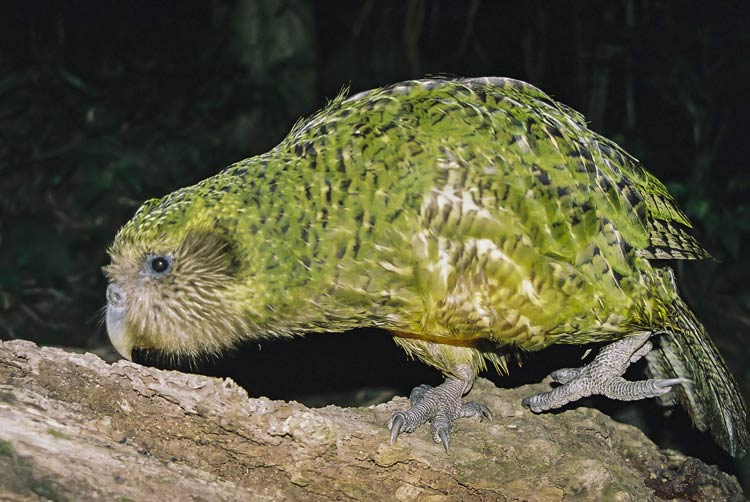
Taxonomy
The kākāpō belongs to the family Strigopidae, which consists of just two species – the kākāpō (Strigops habroptilus) and the kea (Nestor notabilis). The Strigopidae family is unique among parrots in that its members are primarily nocturnal and are adapted to living in forested environments.
Scientific classification
- Kingdom: Animalia
- Phylum: Chordata
- Class: Aves
- Order: Psittaciformes
- Superfamily: Strigopoidea
- Family: Strigopidae
- Genus: Strigops
- Species: Strigops habroptilus
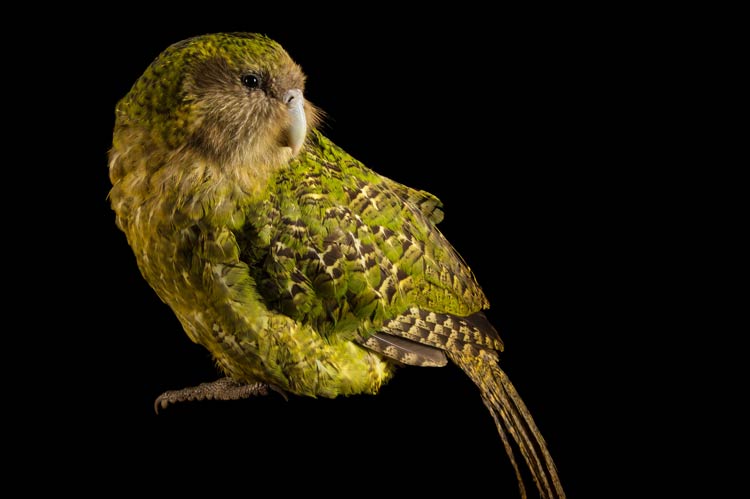
Basic facts about the kākāpō
- The kākāpō, also known as the owl parrot, is a species of parrot endemic to New Zealand.
- Kākāpō is the heaviest parrot species in the world, with males weighing between 1.5 to 3 kilograms (3.3 to 6.6 pounds) and females typically weighing between 0.950 to 1.6 kilograms (2.1 to 3.5 pounds).
- They have distinctive green feathers that are soft and velvety to the touch.
- Kākāpō are flightless and rely on their strong legs to get around.
- They are primarily nocturnal, which is rare for parrots, and are adapted to living in forested environments.
- The kākāpō is a herbivore and feeds mainly on the bark, leaves, and fruit of native trees.
- They have a unique mating system in which males gather in specific areas called “booming grounds” and compete for the attention of females with a series of calls and displays.
- Kākāpō are critically endangered, with only 248 individuals remaining in the wild. They face threats from habitat loss, predation by introduced species, and disease.
- Conservation efforts are underway to help protect the kākāpō and ensure their survival.
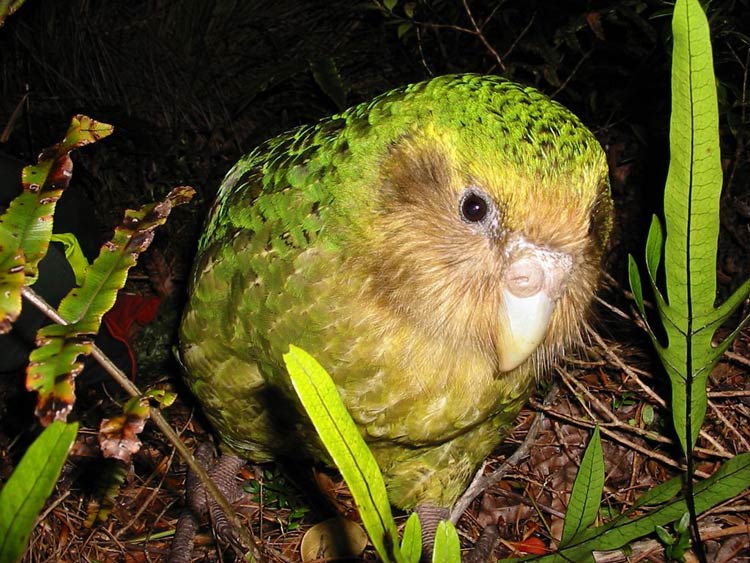
Distribution and habitat
The kākāpō is endemic to New Zealand, meaning that it is only found in this country. Historically, the species was distributed throughout the country, but today, kākāpō populations are limited to a few small offshore islands that are managed as predator-free sanctuaries.
Kākāpō have a unique habitat preference and are adapted to living in forested environments. They prefer areas with mature, podocarp and broadleaf forests, particularly those with a dense understory of shrubs and ferns. This habitat provides ample food sources, shelter, and protection from predators. Kākāpō are also known to inhabit scrubland and tussock grassland habitats in some areas.
Historically, the kākāpō inhabited lowland and mid-altitude forests across New Zealand’s North, South, and Stewart Islands. However, habitat loss and the introduction of mammalian predators, particularly rats, stoats, and cats, have caused the species to retreat to small, predator-free islands where they are better protected. These islands are managed as sanctuaries and are critical to the survival of the species.
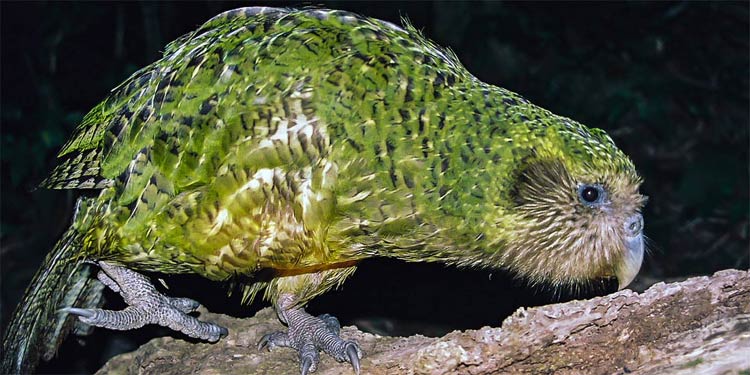
Characteristics
Appearance and size
The kākāpō is a fascinating bird with a unique appearance and striking features. It has a plump, round body with short, sturdy legs and large feet, which it uses to navigate its forested habitat. The kākāpō is also one of the heaviest parrot species in the world, with males weighing between 1.5 to 4 kilograms (3.3 to 9 pounds) and females typically weighing between 0.950 to 1.6 kilograms (2.1 to 3.5 pounds).
One of the most distinctive features of the kākāpō is its soft, velvety green feathers. This unique coat gives the kākāpō a plush, almost cuddly appearance. The green coloration of the feathers also serves as camouflage in its forested environment, making it difficult for predators to spot the bird.
Kākāpōs also have a distinct facial disc, which is made up of small feathers that radiate out from the center of the face. This disc acts as a type of amplifier, helping to project the bird’s calls across long distances in the forest.
While the kākāpō has a relatively plain appearance compared to other parrots, its striking green coat and distinctive facial disc make it easily recognizable in its habitat. Additionally, each individual kākāpō has a unique personal
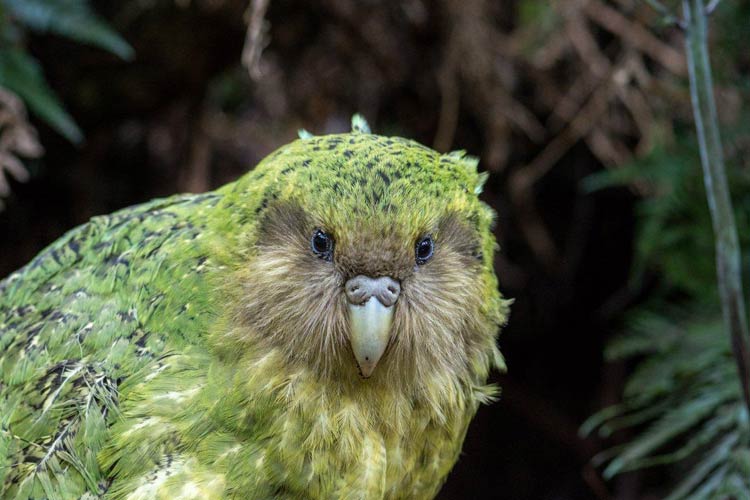
Behavior, lifestyle and ecology
Behavior
- Kākāpō are primarily nocturnal, which is rare for parrots. They are most active at night, using their keen sense of smell to locate food in the dark forest understory.
- Kākāpō are known for their distinctive and loud calls, which can be heard over long distances in the forest. Males gather in specific areas called “booming grounds” and compete for the attention of females with a series of calls and displays.
- Kākāpō are also known for their distinctive personalities. Each individual bird has its own quirks and behaviors, and they are known for being curious and playful.
Lifestyle
- Kākāpō are herbivores, and their diet consists mainly of the bark, leaves, and fruit of native trees. They are also known to eat the roots and tubers of certain plants.
- Kākāpō are adapted to living in forested environments, and they prefer areas with mature, podocarp and broadleaf forests, particularly those with a dense understory of shrubs and ferns.
- Kākāpō are flightless and rely on their strong legs to get around. They are also excellent climbers, using their feet and beaks to climb trees and navigate their forested habitat.
Ecology
- The kākāpō is critically endangered, with only 248 individuals remaining in the wild. They face threats from habitat loss, predation by introduced species, and disease.
- Conservation efforts are underway to help protect the kākāpō and ensure their survival. These efforts include habitat restoration, predator control, and captive breeding programs.
- Kākāpō are a keystone species in their ecosystem, meaning that they play a critical role in maintaining the health and balance of their forest habitat. As seed dispersers, they help to promote the growth and regeneration of native trees and plants.

Diet
The kākāpō is a herbivorous bird with a diet that mainly consists of the bark, leaves, and fruit of native New Zealand trees. Kākāpōs have been observed feeding on the leaves of rimu, kahikatea, and totara trees, as well as the fruit of miro, kahikatea, and rimu trees.
In addition to these primary food sources, kākāpō also consume the roots and tubers of certain plants. They have been observed digging up and consuming the roots of the bracken fern, and they also feed on the roots of the New Zealand flax plant.
Kākāpō are known for their selective feeding habits and will often choose certain parts of a plant over others. For example, they tend to prefer the bark of older trees rather than younger ones, and they will often strip bark from the trunk and branches of a tree rather than eat the leaves.
Because kākāpō are flightless, they rely on their strong legs to navigate their forested habitat and locate food. They are also excellent climbers and will use their feet and beaks to climb trees and reach food sources that are out of reach from the ground.

Reproduction and parenting
The kākāpō has a unique reproductive strategy that has evolved in response to the bird’s nocturnal and arboreal lifestyle. Kākāpōs breed irregularly, with mating typically occurring every 2-4 years when there is an abundance of fruit and seeds in their forest habitat.
Mating behavior is highly ritualized, with males gathering at specific locations known as “booming grounds” to attract females with a series of calls and displays. The males inflate themselves and emit a loud, low-frequency “boom” that can be heard over long distances in the forest. They also emit a distinctive “ching” call that serves as a contact call for females.
Once a female has chosen a mate, she will prepare a nesting site on the ground or in a tree cavity, where she will lay 1-4 eggs. The eggs are incubated for around 30 days, after which the chicks hatch.
Kākāpō chicks are born blind and helpless, and are initially fed by their mother. The female will leave the nest for short periods to gather food, returning to the nest to feed her chicks. After around 10 weeks, the chicks are fully fledged and able to leave the nest.
Kākāpōs are known for their unique parenting behaviors. Unlike most birds, which will leave their young to fend for themselves once they are able to fly, kākāpō mothers will continue to care for their chicks for several months after they leave the nest. They will remain with their young, teaching them important skills such as foraging and vocalizations, until the chicks are able to fend for themselves.
Kākāpōs are also known for their ability to “freeze” in place when threatened, a behavior that may help to protect their young from predators.
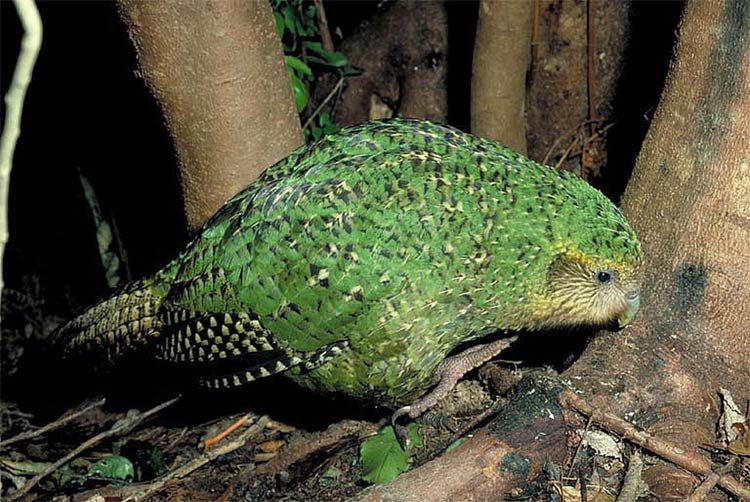
Predators and Threats
Historically, the kākāpō had few natural predators in its native habitat of New Zealand, due in part to the bird’s nocturnal habits and arboreal lifestyle. However, with the arrival of humans and the introduction of mammalian predators, the kākāpō has faced significant threats to its survival.
One of the primary threats to kākāpō population has been predation by introduced mammals such as rats, stoats, and feral cats. These predators can easily climb trees and hunt kākāpō in their roosting sites, which has led to significant declines in kākāpō populations.
Another threat to kākāpō is habitat loss and fragmentation. Kākāpō rely on mature, forested habitats for food and shelter, and deforestation and development have reduced the amount of suitable habitat available for the birds.
Additionally, kākāpōs face threats from disease and genetic issues. The small population size and limited gene pool of the kākāpō make them particularly susceptible to disease outbreaks and genetic abnormalities, which can impact the health and survival of the species.
Conservation efforts are underway to protect and restore kākāpō populations. These efforts include predator control programs, habitat restoration, and captive breeding programs. The kākāpō is currently classified as critically endangered, with only 248 individuals remaining in the wild.

Interactions with humans
The kākāpō has a long history of interactions with humans, dating back to the arrival of Polynesian settlers in New Zealand over a thousand years ago. The bird was highly prized by Māori for its meat, feathers, and ability to mimic human speech, and was hunted to near extinction in some parts of the country.
European colonization of New Zealand in the 19th century brought additional threats to kākāpō populations, as European settlers cleared forests and introduced mammalian predators such as rats and stoats. By the 20th century, the kākāpō was on the brink of extinction, with only a few dozen individuals remaining in isolated pockets of forest.
Since then, efforts have been made to protect and conserve the kākāpō, including the establishment of predator-free island sanctuaries and captive breeding programs. The kākāpō is now considered one of New Zealand’s most iconic and endangered species, and is the focus of ongoing conservation efforts.
The kākāpō has also gained worldwide attention and support due to its unique appearance, behavior, and conservation status. It has been featured in numerous documentaries and conservation campaigns, and is regarded by many as a symbol of the importance of protecting and preserving endangered species.
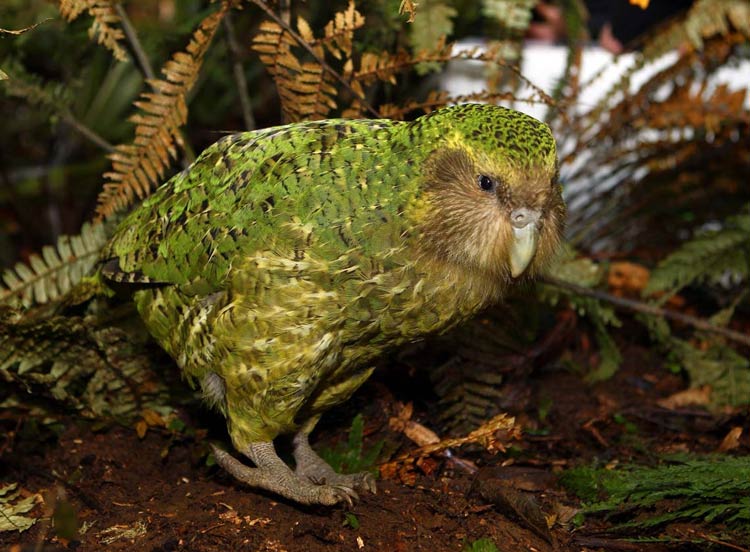
Population
The kākāpō is one of the world’s most endangered birds, with a population that has declined drastically over the past few centuries. In the early 20th century, it was estimated that only a few dozen individuals remained in isolated pockets of forest, and the species was considered on the brink of extinction.
Since then, conservation efforts have been underway to protect and increase kākāpō populations. These efforts have included predator control programs, habitat restoration, and captive breeding programs. As of March 2023, there are 248 kākāpō remaining in the wild and in captivity, making the kākāpō one of the rarest birds in the world.
In addition to the wild population, there are also several kākāpō held in captive breeding programs. These birds are carefully managed and bred to maintain genetic diversity and increase the overall population size. The captive breeding program has been successful in increasing the number of kākāpō, and there are currently over 80 birds in captivity.
While the kākāpō population is still critically endangered, conservation efforts have given hope for the survival of this unique and important species.
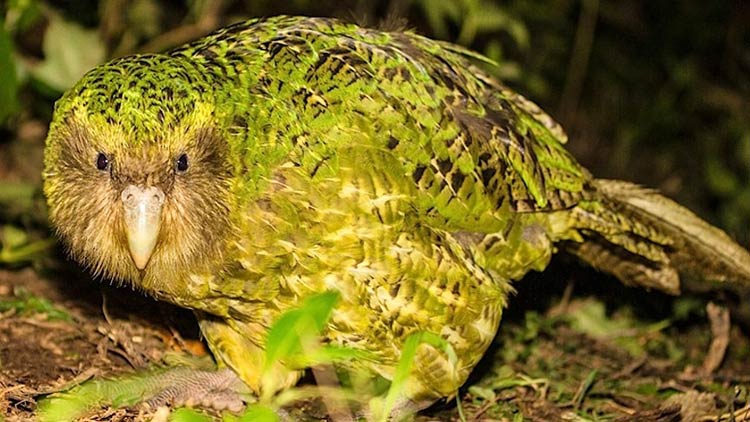
Status and conservation
The kākāpō is one of the most endangered birds in the world and is classified as critically endangered by the International Union for Conservation of Nature (IUCN). The bird faces multiple threats to its survival, including habitat loss, predation by introduced mammals, and low genetic diversity.
Efforts to protect and conserve the kākāpō have been ongoing since the early 20th century, and have become increasingly focused and intensive in recent years. Conservation efforts have included habitat restoration, predator control programs, and captive breeding programs.
The kākāpō recovery program, led by the New Zealand Department of Conservation, has been in place since the 1990s and has successfully increased the number of birds in the wild and in captivity. The program includes intensive management and monitoring of kākāpō populations, as well as breeding and reintroduction initiatives.
One of the most successful aspects of the kākāpō recovery program has been the use of intensive conservation management techniques. For example, each individual bird is given a unique name and closely monitored to ensure its health and safety. In addition, the birds are monitored using radio-tracking technology, and their breeding is closely managed to maintain genetic diversity.
The conservation efforts for the kākāpō have received significant attention and support from around the world, and the bird has become a symbol of the importance of conservation and preservation of endangered species. While the kākāpō still faces significant challenges to its survival, the ongoing
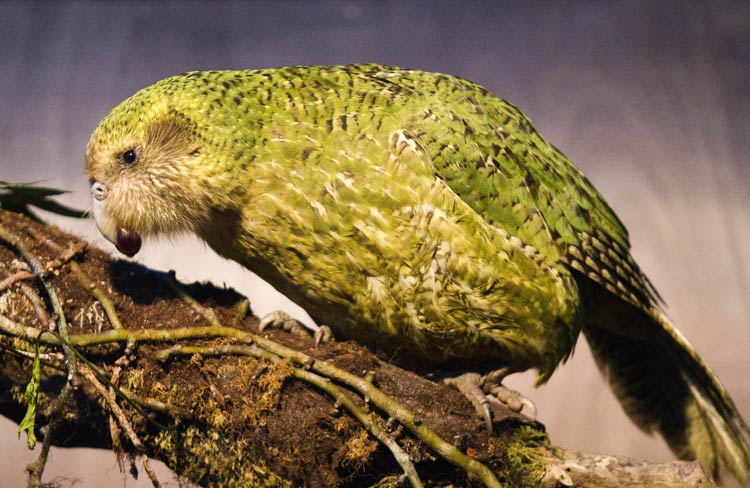
The kākāpō in numbers / dimensions (size)
- Length: Up to 64 cm (25 inches)
- Height:
- Males: up to 58 cm (23 inches)
- Females: up to 56 cm (22 inches)
- Weight:
- Males: 1.5–3 kilograms (3.3–6.6 lb)
- Females: 0.950–1.6 kilograms (2.1–3.5 lb)
- Wingspan: 82 cm (32 in)
- Lifespan: up to 100 years
- Max speed: up to 6 km/h (3.7 mph)

The kākāpō in culture
The kākāpō has a special place in New Zealand culture and mythology. In Māori culture, the bird is known as a taonga, or treasure, and is believed to be a messenger of the gods. Its distinctive call, which can be heard over long distances, is said to represent the voices of ancestors.
The kākāpō has also become an icon of conservation in New Zealand and around the world. Its unique appearance, behaviors, and challenges have captured the attention of scientists, artists, and the general public, and it has been the subject of numerous documentaries, books, and other media.
One example of the kākāpō’s cultural significance is the annual Kākāpō Recovery Calendar, which features photographs and illustrations of the birds, as well as information about the conservation efforts to protect them. The calendar is popular with conservationists, bird enthusiasts, and anyone who appreciates the beauty and uniqueness of the kākāpō.
In recent years, the kākāpō has also become a popular internet meme, with videos and images of the birds being shared widely on social media. This has helped to raise awareness of the kākāpō’s conservation status and the ongoing efforts to protect it.
Overall, the kākāpō’s cultural significance reflects its importance as a unique and precious species that is deeply intertwined with the natural and cultural heritage of New Zealand.
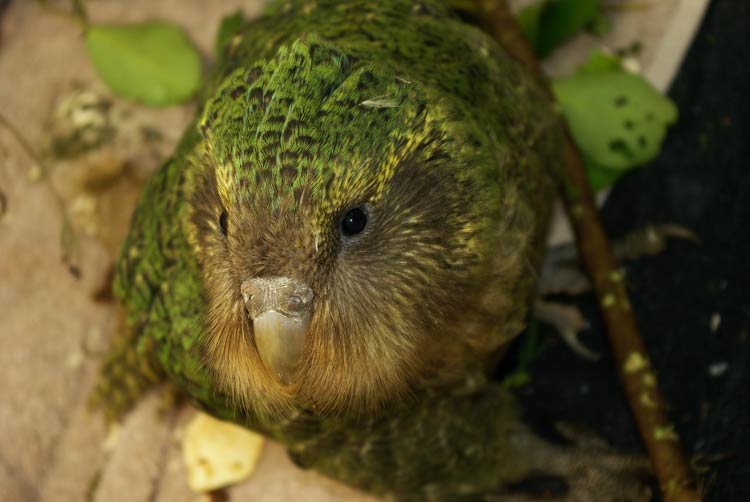
The kākāpō in movies
The kākāpō has been featured in a number of documentaries and films, particularly those focused on conservation and the unique wildlife of New Zealand. One of the most well-known documentaries about the kākāpō is “Kakapo: Night Parrot”, which was produced by the BBC and features stunning footage of the birds in their natural habitat.
Another popular documentary about the kākāpō is “Last Chance to See”, a series that follows writer Douglas Adams and zoologist Mark Carwardine as they travel the world in search of endangered species. The kākāpō is one of the species featured in the series, and the documentary provides an engaging and informative look at the bird’s unique behaviors and conservation challenges.
In addition to documentaries, the kākāpō has also appeared in several feature films, including the New Zealand-made movie “The Dark Horse”. The film tells the story of a former chess champion who mentors a group of disadvantaged children, one of whom has a special interest in the kākāpō.
Overall, the kākāpō’s appearances in film and television reflect the bird’s cultural significance and the growing awareness of the need to protect it and other endangered species.
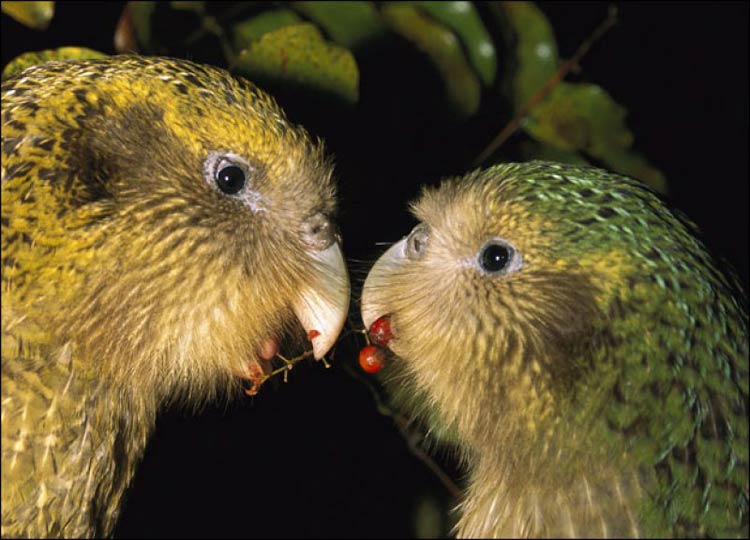
Interesting facts about the kākāpō
- Kākāpō are the heaviest parrots in the world, with males weighing up to 4 kg (9 lb) and females weighing up to 1.6 kg (3.5 lb).
- Kākāpōs are flightless, with small wings that are only used for balance and display during mating.
- Kākāpōs are nocturnal and spend their days sleeping in hollows or on the ground.
- Kākāpōs have a unique musky odor, which is believed to help attract mates.
- Kākāpōs have a distinctive booming call, which can be heard up to 5 km (3 miles) away.
- Kākāpōs are herbivores and feed mainly on the leaves, bark, and fruit of native New Zealand plants.
- Kākāpōs are polygynous, meaning that males mate with multiple females.
- Kākāpōs have a high degree of sexual dimorphism, with males having a brighter green coloration and a more prominent facial disc than females.
- Kākāpōs have a slow reproductive rate and only breed during years when there is a high abundance of food.
- Kākāpōs are critically endangered, with a population of only 248 individuals as of 2023. They are one of the world’s most endangered species and are the focus of intensive conservation efforts in New Zealand.
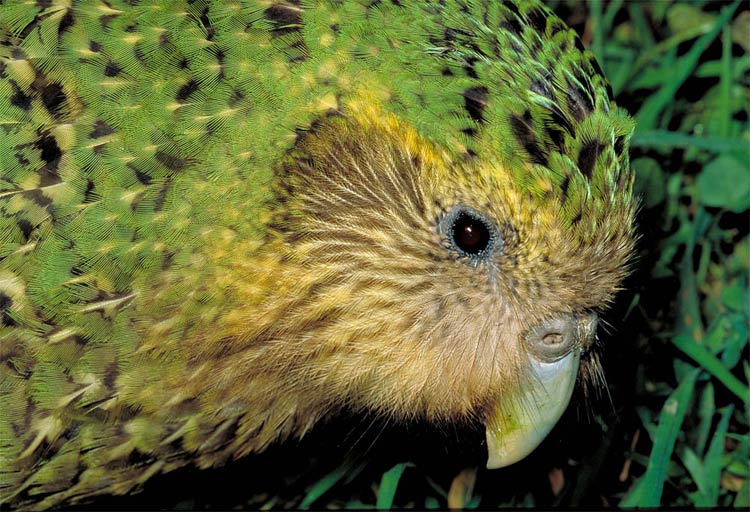
Q&A (questions and answers) about the kākāpō
Q: What is a kākāpō?
A: The kākāpō is a species of large, flightless parrot that is native to New Zealand.
Q: How big are kākāpō?
A: Kākāpō can grow up to 64 cm (25 inches) in length and weigh up to 3 kg (6.6 lb) for males and 1.6 kg (3.5 lb) for females.
Q: What is the lifespan of a kākāpō?
A: Kākāpō can live up to 100 years, making them one of the longest-lived bird species in the world.
Q: Are kākāpō endangered?
A: Yes, kākāpō are critically endangered, with a population of only around 200 individuals as of 2023. They are one of the world’s most endangered species and are the focus of intensive conservation efforts in New Zealand.
Q: What is the diet of a kākāpō?
A: Kākāpō are herbivores and feed mainly on the leaves, bark, and fruit of native New Zealand plants.
Q: Are kākāpō social birds?
A: Kākāpō are solitary birds that only come together during the breeding season.
Q: Why are kākāpō considered unusual parrots?
A: Kākāpō are considered unusual parrots because they are flightless, nocturnal, and have a highly unusual mating system.
Q: Can kākāpō fly?
A: No, kākāpō are flightless, with small wings that are only used for balance and display during mating.
Q: How are kākāpō protected in New Zealand?
A: Kākāpōs are protected in New Zealand through a range of conservation efforts, including habitat restoration, predator control, and captive breeding programs.
Q: How can people help protect kākāpō?
A: People can help protect kākāpō by supporting conservation efforts, donating to kākāpō conservation organizations, and spreading awareness about the species and its conservation challenges.
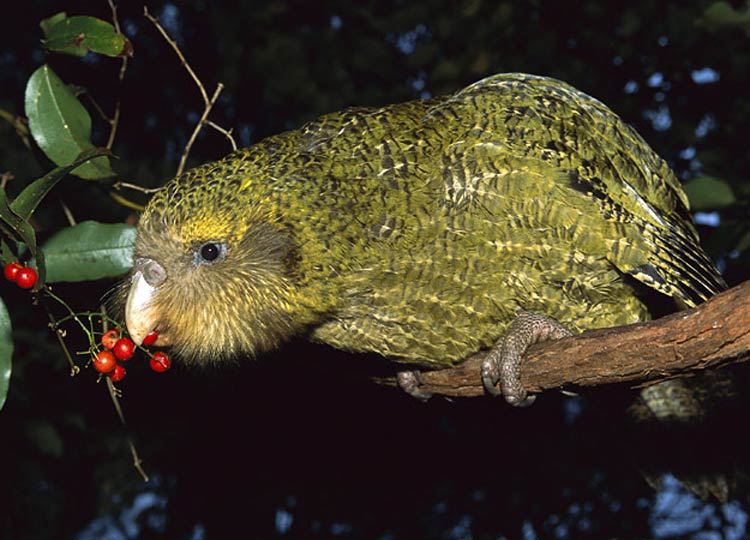
Recommended
- African lion
- Asian lion
- African elephant
- African forest elephant
- Asian elephant
- Moose
- Owls
- Parrots
- Giraffe
- Gorillas
- Zebroid
- Zebra
- Giant anteater
- Lizards
- Toucans
- Lemurs
- Secretarybird
- Ants










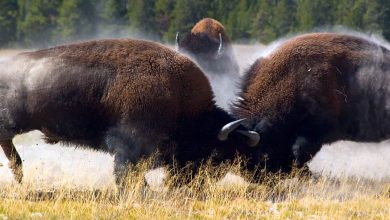



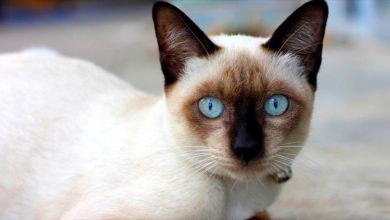
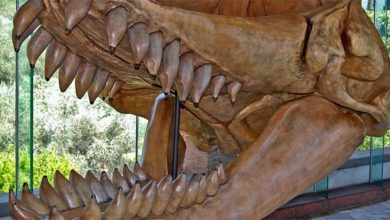



OMG, the Kakapo bird is so cool! It’s a giant flightless parrot that lives in New Zealand. I wish I could see one in real life!